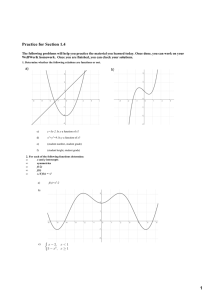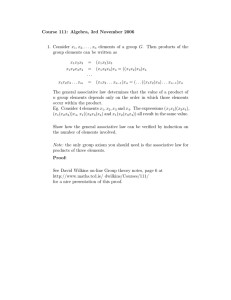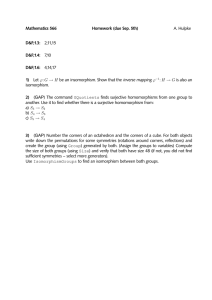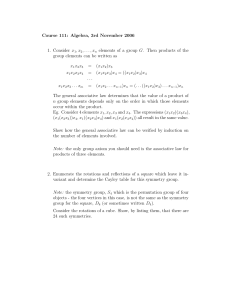Symmetry Generation of Constraint Models and the Alan M. Frisch
advertisement
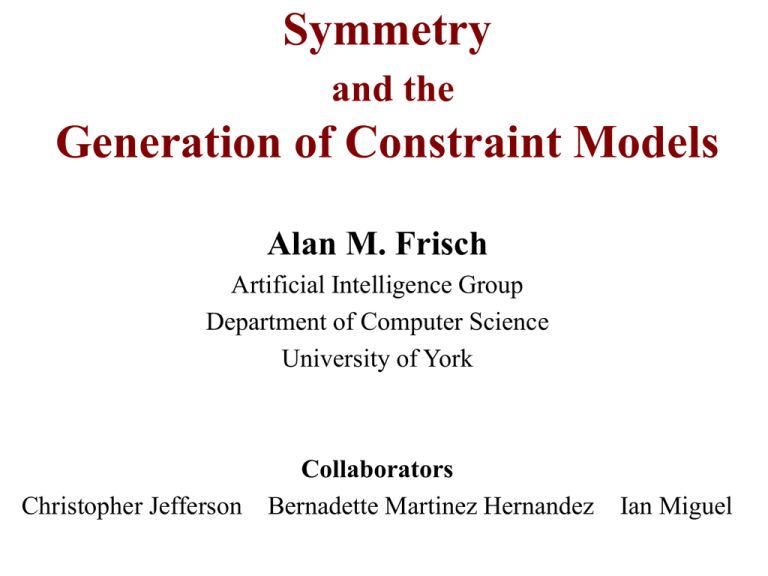
Symmetry
and the
Generation of Constraint Models
Alan M. Frisch
Artificial Intelligence Group
Department of Computer Science
University of York
Christopher Jefferson
Collaborators
Bernadette Martinez Hernandez Ian Miguel
What is Constraint Programming?
• Solve a combinatorial (optimisation) problem by
– Mapping it to the finite-domain constraint satisfaction
problem (modelling)
• Characterise problem by a set of constraints that a solution must
satisfy
• For optimisation, include an objective function
– Solving the constraint satisfaction problem
– Mapping solution to CSP to solution to original problem
• Useful for solving a wide range of important,
complex problems including scheduling, allocation,
layout and configuration problems.
Symmetry
• Models often contain an enormous number of
symmetries.
• Symmetry in a model yields symmetry in the space
that is searched for a solution, which leads to
inefficiency.
• Once symmetries in the model are identified, there
are a variety of methods for removing it from the
model or from the search.
• How do we identify them?
Conclusion
• Symmetries enter a model from two sources:
– inherent in the problem
– introduced by the modelling process
• The modelling process can be formalised and
automated [IJCAI-05].
• A formal/automated account of modelling should
provide a formal/auomated account of the
symmetries introduced by modelling.
The Plan
• Constraint satisfaction problems and their
symmetries
• An introduction to modelling (by example)
• The automation of modelling
• Automatic identification of symmetry introduced by
modelling
Part 1
Constraint Satisfaction Problems
and their Symmetries
The Constraint Satisfaction Problem
An instance of the finite domain CSP consists of
• Finite set of variables X1,…,Xn, having finite
domains D1,…,Dn.
• Finite set of constraints. Each restricts the values
that the variables can simultaneously take.
Example: x y. x+y<z.
Solutions of a CSP Instance
• A total instantiation maps each variable to
an element in its domain.
• A solution to a CSP instance is a total
instantiation that satisfies all the constraints.
• Problem: Given an instance
–
–
–
–
Determine if it is satisfiable (has a solution)
Find a solution
Find all solutions
Find optimal solution
Example of a CSP
Problem: Find three distinct digits that sum to 4.
X, Y, Z in {0,1,2,3,4,5,6,7,8,9}
X Y, Y Z, X Z
X+Y+Z=4
A Solution: map X to 0, Y to 1, Z to 3
What Is Symmetry?
• A symmetry is a total bijective function from total
instantiations to total instantiations which maps
every solution to a solution.
• Usually consider a set of symmetries that is closed
under inverse and composition and to contain
identity function, i.e. a group.
• This induces a partitioning on the total
instantiations. Each partition is called a symmetry
class. Every member is a solution or no member is.
• In general, other objects can be mapped and other
properties preserved.
Value Symmetry
• A group of symmetries on values that induces a
group of symmetries on instantiations.
• Example: “Assign r, b or g to each node of a
graph so that no arc connects two nodes of the
same colour” has value symmetry.
S = {r to b, b to g, g to r}.
• Induces a symmetry on instantiations that maps
{N1 to r, N2 to b, N3 to g} to
{N1 to S(r), N2 to S(b), N3 to S(g)} =
{N1 to b, N2 to g, N3 to r}
Variable Symmetry
• A group of symmetries on variables that induces a
group of symmetries on instantiations.
• Example: “Assign 0,…,9 to X, Y, Z such that X,
Y, Z are all different and sum to 4” has variable
symmetry.
S = {X to Y, Y to Z, Z to X}.
• Induces a symmetry on instantiations that maps
{X to 0, Y to 1, Z to 3} to
{S(X) to 0, S(Y) to 1, S(Z) to 2} =
{Y to 0, Z to 1, X to 2}
Partial Instantiation Search
(Forward Checking)
1
0
0
0
0
1
0 0
0 1
0 1
0
0 0 0
0 1
0 0 1
0 1 1
X
!
0 1
0 0
0 0
1 0
0 1
0 1
0 0 0
1 0
X
0 1 0
0 0
0 1 1
0 0 1
X
!
0 1 0
0 1 1
!
0 1 1
0 1 0
!
0 1
1 1
0 0 1
1 0 1
!
0 1 0
1 1 0
0 1 1
1 1
!
X
How to Break Symmetries
• Be clever during search (SBDS, SBDD, …)
• Reformulate the problem
• Add symmetry breaking constraints to problem
formulation.
– Consistent: At least one instantiation in every
symmetry class satisfies the constraints.
– Complete: At most one instantiation in every
symmetry class satisfies the constraints.
– Enforcing these constraints during search prunes
paths---solution paths and failure paths.
Part 2
An Introduction to Modelling
(by example)
Model: Explicit Representation
Given n and s,
find a set of n non-zero digits that sum to s.
… n
1..9 1..9 1..9 … 1..9
1
X
given
find
such that
2
3
n:int, s:int
X: matrix (indexed by 1.. n) of 1..9
AllDiff(X)
?
Si1..n X[i] = s
Symmetries: permutations of the index values
Model: Occurrence Representation
Given n and s,
find a set of n non-zero digits that sum to s.
D
given
find
such that
1
2
3 … 9
0/1 0/1 0/1 … 0/1
n:int, s:int
D: matrix (indexed by 1..9) of 0..1
?D[1] + 2D[2] + … + 9D[9] = s
D[1] + D[2] + … + D[9] = n
Symmetries: none
The SONET Problem
Specification
• Given nrings rings, nnodes nodes, a set of pairs of nodes
(communication demand) and an integer capacity (of each
ring). Install nodes on rings satisfying demand and capacity
constraints. Minimise installations.
Instance
• nrings=2, nnodes=5, capacity = 4
• demand: n1 & n3, n1 & n4, n2 & n3, n2 & n4, n3 & n5
Solution
n2
n1
n3
n4
n3
n5
Model of the SONET Problem
Rings
Nodes
0..1 0..1
0..1 0..1
0..1 0..1
0..1 0..1
0..1 0..1
0..1 0..1
0..1 0..1
0..1 0..1
0..1 0..1
0..1 0..1
0..1 0..1
0..1 0..1
Symmetries:
•Permute the 2nd index
(columns)
The Social Golfers Problem
A number of golfers play a round of golf in each
of nweeks weeks. Each week they are divided
into ngroups, each of which plays together. To
maximise socialisation, no two golfers can play
together twice. How should the golfers be
divided each week?
groups
weeks
[1,2,3]
[4,5,6]
[7,8,9]
[1,4,7]
[2,5,8]
[3,6,9]
[1,5,9]
[2,6,7]
[3,4,8]
Model Social Golfers Problem
groups
weeks
[1,2,3]
[4,5,6]
[7,8,9]
[1,4,7]
[2,5,8]
[3,6,9]
[1,5,9]
[2,6,7]
[3,4,8]
Symmetries
•Permutations of the values
•Permutations of the first index (rows)
•Permutations of the second index (columns)
•Permutation of the third index
Model Social Golfers Problem
groups
weeks
[1,2,3]
[4,5,6]
[7,8,9]
[1,4,7]
[2,5,8]
[3,6,9]
[1,5,9]
[2,6,7]
[3,4,8]
Symmetries
•Permutations of the values
•Permutations of the first index (rows)
•Within each row, permutations of the 2nd index (cols)
•Within each cell, permutations of the 3rd index
Part 3
Automated Modelling
Modelling Bottleneck
• Modelling a problem as a constraint
program requires moderate/great expertise.
• Hence constraint technology is used almost
exclusively by large enterprises on
problems with large payoff.
Reducing the Modelling Bottleneck
• Systematise the knowledge of the expert.
– ~5 years: We have been building models more and
more systematically
• Embed this knowledge in a “compiler” that can
refine a high-level problem specification into a
set of constraints that can be executed efficiently
using existing toolkits.
CONJURE
Automated Model Generation
• Given an abstract formal problem specification, in
ESSENCE
• Generates a set of correct models
– Should include good models generated by experts
– These models are in ESSENCE', a subset of ESSENCE
similar to what is provided by existing constraint toolkits
– ESSENCE must enable specification at a level of
abstraction above that at which modelling decisions
are made
ESSENCE
• The language enables problems to be specified
at a level of abstraction above that at which
modelling decisions are made.
• This requires features not found in current
constraint programming languages.
SONET Specification
given
nrings :int, nnodes:int, capacity:int
where
nrings > 0, nnodes > 0, capacity > 0
letting
Nodes be 1..nnodes
given
demand: set of set (size 2) of Nodes
find
rings: mset (size nrings) of set (maxsize capacity) of Nodes
minimising S r rings .|r|
such that pair demand . r rings . pair r
ESSENCE Provides Abstract Types
Sets, Multisets, Partitions, Range Types, Unnamed Types
Functions, Relations, Enumerated Types, Sequences…
given
nrings:int, nnodes:int, capacity:int
where
nrings > 0, nnodes > 0, capacity > 0
letting
Nodes be 1..nnodes
given
demand: set of set (size 2) of Nodes
find
rings: mset (size nrings) of set (maxsize capacity) of Nodes
minimising S r rings .|r|
such that pair demand . r rings . pair r
Abstract types
ESSENCE Supports
Arbitrarily-Nested Types
given
nrings:int, nnodes:int, capacity:int
letting
nrings > 0, nnodes > 0, capacity > 0 Arbitrary nesting
of types
Nodes be 1..nnodes
given
demand: set of set (size 2) of Nodes
find
rings: mset (size nrings) of set (maxsize capacity) of Nodes
minimising
Sr rings .|r|
where
such that pair demand . r rings . pair r
ESSENCE Supports Quantification
over Decision Variables
given
nrings:int, nnodes:int, capacity:int
where
nrings > 0, nnodes > 0, capacity > 0
letting
Nodes be 1..nnodes
given
demand: set of set (size 2) of Nodes
find
rings: mset (size nrings) of set (maxsize capacity) of Nodes
minimising S r rings .|r|
such that pair demand . r rings . pair r
Quantifying
Over Decision
Variables
How Usable is ESSENCE?
• Specifications of ~50 problems found in the
CSP literature written by an undergraduate with
no background in constraint programming.
• URL: http://www.cs.york.ac.uk/aig/constraints/
ESSENCE’
Abstract types
ESSENCE’ = ESSENCE -
Arbitrary nesting
of types
Quantifying
Over Decision
Variables
• ESSENCE’ has a similar level of abstraction
to existing constraint languages.
Model Generation: Informal
Given n and s, find a set of n non-zero
digits that sum to s.
ESSENCE’
n:int, s:int
given
X: matrix (indexed by 1.. n) of 1..9
find
such that AllDiff(X)
Si1..n X[i] = s
given
find
such that
ESSENCE’
n:int, s:int
D: matrix (indexed by 1..9) of 0..1
D[1] + 2D[2] + … + 9D[9] = s
D[1] + D[2] + … + D[9] = n
Formalisation of Model Generation
given
n:int, s:int
find
X: set (size n) of 1..9
such that S x = s
xX
ESSENCE’
n:int, s:int
given
X: matrix (indexed by 1.. n) of 1..9
find
such that AllDiff(X)
Si1..n X[i] = s
given
find
such that
ESSENCE’
n:int, s:int
D: matrix (indexed by 1..9) of 0..1
D[1] + 2D[2] + … + 9D[9] = s
D[1] + D[2] + … + D[9] = n
Part 4
Automated Identification of
Symmetries Introduced by
Modelling
CONJURE Identifies Symmetries
• CONJURE annotates the models it produces with
the symmetries it introduces.
• As model is generated, each refinement rule
generates appropriate annotations
Refinement of the SONET Problem
Refine: rings:mset (size nrings) of
set (size capacity) of Nodes
Refine mset (size n) of tau to
Explicit
a matrix (indexed by1..n) of refine(tau)
Symmetries: permutations of the index values of the matrix
symmetries introduced by refine(tau)
Refine set (size n) of tau to
Occurrence
a matrix (indexed by tau) of bool
provided tau is bool, finite set of int, enumerated type
Symmetries: none
Model of the SONET Problem
Rings
Nodes
0..1 0..1
0..1 0..1
0..1 0..1
0..1 0..1
0..1 0..1
0..1 0..1
0..1 0..1
0..1 0..1
0..1 0..1
0..1 0..1
0..1 0..1
0..1 0..1
Symmetries:
•Permute the 2nd index
(columns)
Refinement of the Golfers Problem
Refine: schedule: mset (size nweeks) of
regpart (size ngroups) of golfers
Refine mset (size n) of tau to
Explicit
a matrix (indexed by1..n) of refine(tau)
Symmetries: -permutations of the index values of the matrix
-each element of the matrix independently has
every symmetry of refine(tau)
Refine regpart (size n) of tau to
a matrix (indexed by 1..n, |tau| / n) of refine(tau)
Symmetries: - permutations of the values of the 1st index
- within each row, permutations of values of 2nd index
Refine newtype (size n) to 1..n
Symmetries: - permutions of the values 1..n
Model Social Golfers Problem
groups
weeks
[1,2,3]
[4,5,6]
[7,8,9]
[1,4,7]
[2,5,8]
[3,6,9]
[1,5,9]
[2,6,7]
[3,4,8]
Symmetries
•Permutations of the values
•Permutations of the first index (rows)
•Within each row, permutations of the 2nd index (cols)
•Within each cell, permutations of the 3rd index
Conclusion
• Symmetry enters a model from two sources:
– It is inherent in the problem
– It is introduced by the modelling process
• The modelling process can be formalised and
automated [IJCAI-05].
• A formal/automated account of modelling should
provide a formal/automated account of the
symmetries introduced by modelling.
Further Information
• “The Rules of Constraint Modelling” at IJCAI on
Wednesday
• http://www.cs.york.ac.uk/aig/constraints/
–
–
–
–
Our papers
Catalog of CONJURE rules
Syntax and semantics of ESSENCE version 1
Catalog of ~50 problems specified in ESSENCE and
other constraint languages
